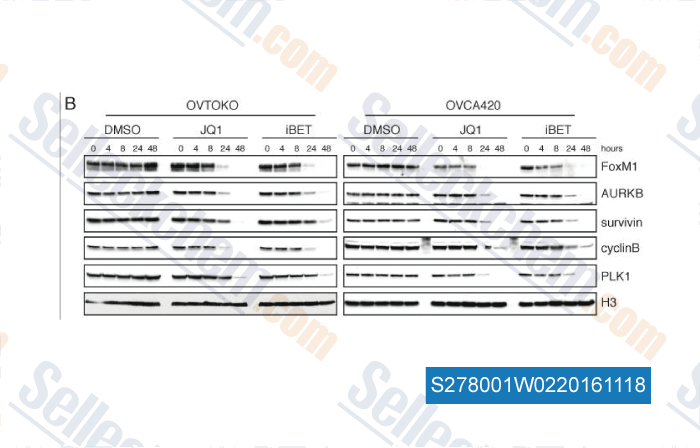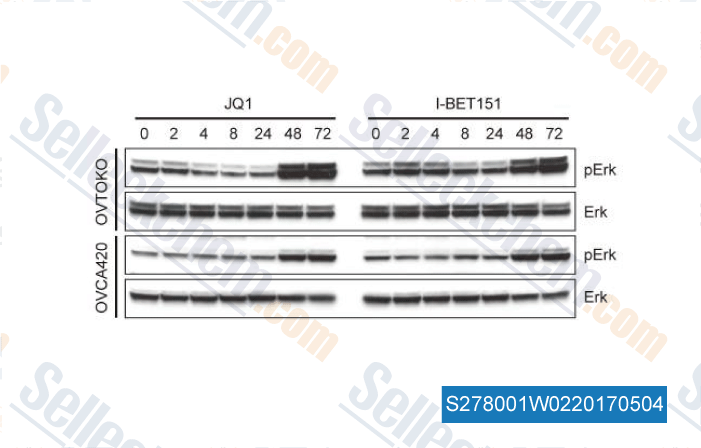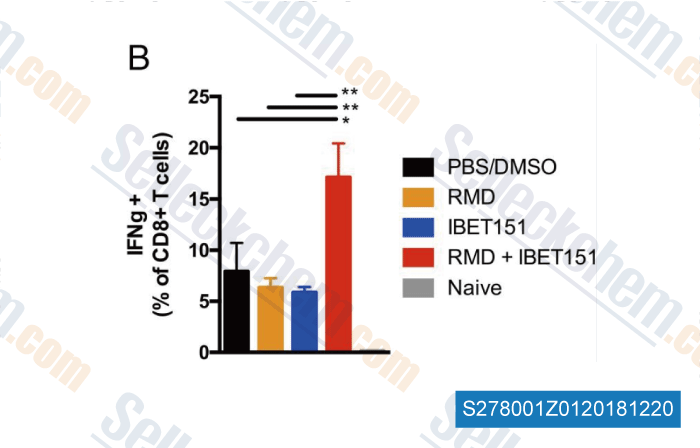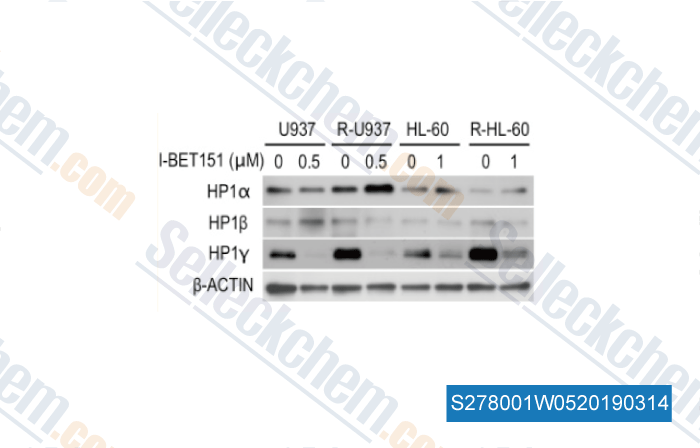|
Toll Free: (877) 796-6397 -- USA and Canada only -- |
Fax: +1-832-582-8590 Orders: +1-832-582-8158 |
Tech Support: +1-832-582-8158 Ext:3 Please provide your Order Number in the email. |
Technical Data
| Formula | C23H21N5O3 |
|||
| Molecular Weight | 415.44 | CAS No. | 1300031-49-5 | |
| Solubility (25°C)* | In vitro | DMSO | 83 mg/mL (199.78 mM) | |
| Ethanol | 27 mg/mL (64.99 mM) | |||
| Water | Insoluble | |||
|
* <1 mg/ml means slightly soluble or insoluble. * Please note that Selleck tests the solubility of all compounds in-house, and the actual solubility may differ slightly from published values. This is normal and is due to slight batch-to-batch variations. * Room temperature shipping (Stability testing shows this product can be shipped without any cooling measures.) |
||||
Preparing Stock Solutions
Biological Activity
| Description | I-BET151 (GSK1210151A) is a novel selective BET inhibitor for BRD2, BRD3 and BRD4 with IC50 of 0.5 μM, 0.25 μM, and 0.79 μM in cell-free assays, respectively. | ||||||
|---|---|---|---|---|---|---|---|
| Targets |
|
||||||
| In vitro | I-BET151 exhibits potent selectivity over an extensive range of diverse protein types such as COX-2, P450, Aurora B, GSK3β, PI3K-γ, GPCR, ion channels, and transporters. Similar to I-BET762 (GSK525762A), I-BET151 displays potent binding affinity to BRD2, BRD3 and BRD4 with KD of 0.02-0.1 μM, and significantly inhibits lipopolysaccharide-stimulated IL-6 cytokine production in human peripheral blood mononuclear cells (PBMC) and whole blood (WB) as well as rat WB with IC50 of 0.16 μM, 1.26 μM, and 1.26 μM, respectively. I-BET151 (0.5 or 5 μM) inhibits the binding of BETs (BRD2, BRD3, BRD4, and BRD9) but not the binding of 23 other bromodomain proteins in HL60 nuclear extract to acetylated histone peptides. I-BET151 has potent efficacy against cell lines harboring different MLL-fusions such as MV4;11, RS4;11, MOLM13, and NOMO1 cells with IC50 of 15-192 nM. Consistently, I-BET151 completely ablates the colony-forming potential of MLL-fusion-driven leukaemias (MOLM13) but not leukaemias driven by tyrosine kinase activation (K562). I-BET151 also displays potent efficacy in both liquid culture and clonogenic assays using primary murine progenitors transformed with either MLL-ENL or MLL-AF9. I-BET151 treatment significantly induces apoptosis and prominent G0/G1 arrest in MLL-fusion cell lines driven by distinct MLL fusions (MOLM13 and MV4;11 containing MLL-AF9 and MLL-AF4, respectively) but not the K562 cells, probably due to the inhibition of transcription of BCL2, C-MYC and CDK6 by blocking the recruitment of BRD3/4, PAFc and SEC components into transcriptional start site (TSS). [1] | ||||||
| In vivo | Administration of I-BET151 at 30 mg/kg/day significantly inhibits tumor growth of murine MLL-AF9 and human MLL-AF4 leukaemia in mice, and provides marked survival benefit. [1] | ||||||
| Features | Optimized to retain excellent BET target potency and selectivity while enhancing the in vivo pharmacokinetics and terminal half-life to enable prolonged in vivo studies. |
Protocol (from reference)
| Kinase Assay: |
|
|---|---|
| Cell Assay: |
|
| Animal Study: |
|
Customer Product Validation

-
Data from [Data independently produced by , , Theranostics, 2016, 6(2):219-30.]

-
Data from [Data independently produced by , , Oncotarget, 2016, 7(3):2545-54]

-
Data from [Data independently produced by , , J Immunol, 2018, 201(9):2744-2752]

-
Data from [Data independently produced by , , Front Pharmacol, 2018, 9:1166]
Selleck's I-BET151 (GSK1210151A) has been cited by 59 publications
| Synergy of retinoic acid and BH3 mimetics in MYC(N)-driven embryonal nervous system tumours [ Br J Cancer, 2024, 10.1038/s41416-024-02740-5] | PubMed: 38942989 |
| Direct reprogramming of fibroblasts into spiral ganglion neurons by defined transcription factors [ Cell Prolif, 2024, e13775.] | PubMed: 39551613 |
| Analysis of synthetic cellular barcodes in the genome and transcriptome with BARtab and bartools [ Cell Rep Methods, 2024, S2667-2375(24)00094-8] | PubMed: 38670101 |
| Integrator complex subunit 12 knockout overcomes a transcriptional block to HIV latency reversal [ bioRxiv, 2024, 2024.08.30.610517] | PubMed: 39257755 |
| A Crispr Screen of HIV Dependency Factors to Identify Host Proteins Necessary for Activation of Latent HIV Proviruses [ ResearchWorks Archive, 2024, ] | PubMed: none |
| Inhibition of neutral sphingomyelinase 2 impairs HIV-1 envelope formation and substantially delays or eliminates viral rebound [ Proc Natl Acad Sci U S A, 2023, 120(28):e2219543120] | PubMed: 37406092 |
| RUNX1 colludes with NOTCH1 to reprogram chromatin in T cell acute lymphoblastic leukemia [ iScience, 2023, 26(6):106795] | PubMed: 37213235 |
| RUNX1 colludes with NOTCH1 to reprogram chromatin in T cell acute lymphoblastic leukemia [ iScience, 2023, 26(6):106795] | PubMed: 37213235 |
| Enhancer Clusters Drive Type I Interferon-Induced TRAIL Overexpression in Cancer, and Its Intracellular Protein Accumulation Fails to Induce Apoptosis [ Cancers (Basel), 2023, 15(3)967] | PubMed: 36765925 |
| A CRISPR Screen of HIV Dependency Factors Reveals That CCNT1 Is Non-Essential in T Cells but Required for HIV-1 Reactivation from Latency [ Viruses, 2023, 15(9)1863] | PubMed: 37766271 |
RETURN POLICY
Selleck Chemical’s Unconditional Return Policy ensures a smooth online shopping experience for our customers. If you are in any way unsatisfied with your purchase, you may return any item(s) within 7 days of receiving it. In the event of product quality issues, either protocol related or product related problems, you may return any item(s) within 365 days from the original purchase date. Please follow the instructions below when returning products.
SHIPPING AND STORAGE
Selleck products are transported at room temperature. If you receive the product at room temperature, please rest assured, the Selleck Quality Inspection Department has conducted experiments to verify that the normal temperature placement of one month will not affect the biological activity of powder products. After collecting, please store the product according to the requirements described in the datasheet. Most Selleck products are stable under the recommended conditions.
NOT FOR HUMAN, VETERINARY DIAGNOSTIC OR THERAPEUTIC USE.
